Critique of Narrative Nursing Notes in Electronic Health Records
VerifiedAdded on 2021/05/31
|10
|2503
|157
Report
AI Summary
This report critically analyzes the use of narrative nursing notes within electronic health records (EHRs) as a key communication tool in nursing practice. It explores the importance of proper documentation for effective communication and patient outcomes, contrasting paper-based and electronic systems. The report discusses the strengths of narrative notes in documenting critical events and individualizing care, while also addressing limitations such as decreased readability and usability within EHRs. It reviews relevant studies and research to support the analysis, and provides recommendations for improving the integration of narrative notes in EHRs, including co-signing notes, collaboration with specialists, and fostering both electronic and verbal communication. The conclusion emphasizes the need for effective strategies to ensure the use of electronic nursing notes for improved patient care.
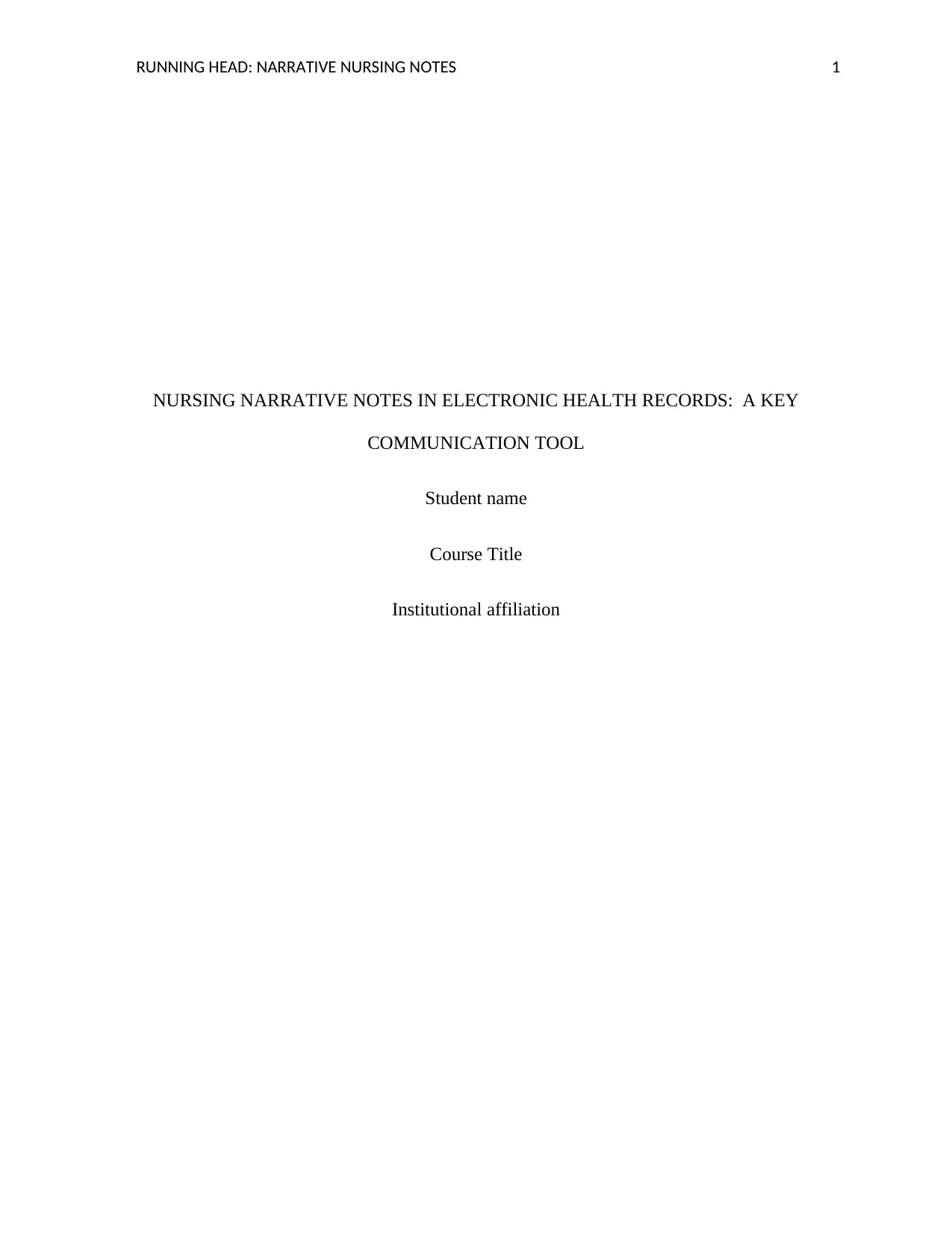
RUNNING HEAD: NARRATIVE NURSING NOTES 1
NURSING NARRATIVE NOTES IN ELECTRONIC HEALTH RECORDS: A KEY
COMMUNICATION TOOL
Student name
Course Title
Institutional affiliation
NURSING NARRATIVE NOTES IN ELECTRONIC HEALTH RECORDS: A KEY
COMMUNICATION TOOL
Student name
Course Title
Institutional affiliation
Paraphrase This Document
Need a fresh take? Get an instant paraphrase of this document with our AI Paraphraser
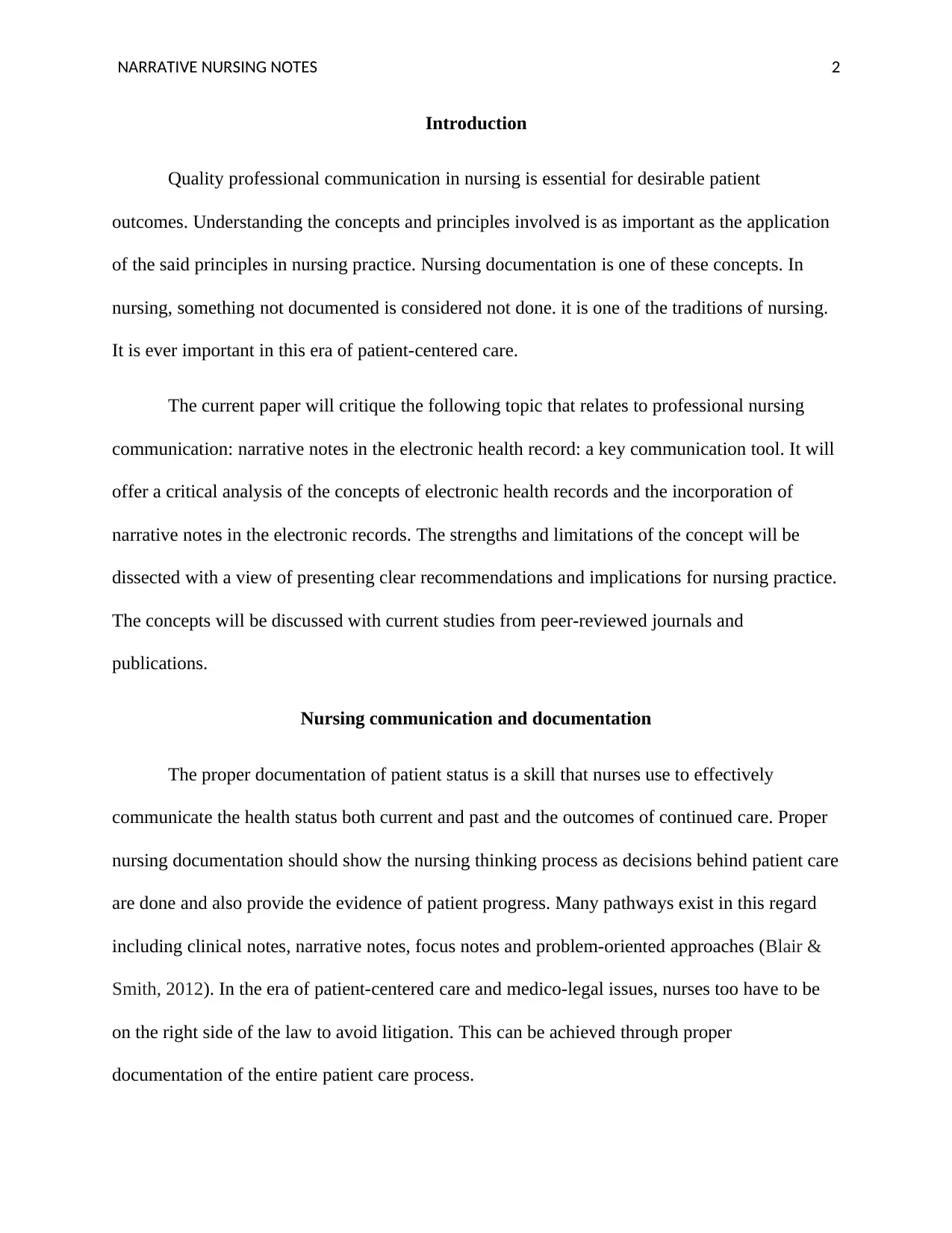
NARRATIVE NURSING NOTES 2
Introduction
Quality professional communication in nursing is essential for desirable patient
outcomes. Understanding the concepts and principles involved is as important as the application
of the said principles in nursing practice. Nursing documentation is one of these concepts. In
nursing, something not documented is considered not done. it is one of the traditions of nursing.
It is ever important in this era of patient-centered care.
The current paper will critique the following topic that relates to professional nursing
communication: narrative notes in the electronic health record: a key communication tool. It will
offer a critical analysis of the concepts of electronic health records and the incorporation of
narrative notes in the electronic records. The strengths and limitations of the concept will be
dissected with a view of presenting clear recommendations and implications for nursing practice.
The concepts will be discussed with current studies from peer-reviewed journals and
publications.
Nursing communication and documentation
The proper documentation of patient status is a skill that nurses use to effectively
communicate the health status both current and past and the outcomes of continued care. Proper
nursing documentation should show the nursing thinking process as decisions behind patient care
are done and also provide the evidence of patient progress. Many pathways exist in this regard
including clinical notes, narrative notes, focus notes and problem-oriented approaches (Blair &
Smith, 2012). In the era of patient-centered care and medico-legal issues, nurses too have to be
on the right side of the law to avoid litigation. This can be achieved through proper
documentation of the entire patient care process.
Introduction
Quality professional communication in nursing is essential for desirable patient
outcomes. Understanding the concepts and principles involved is as important as the application
of the said principles in nursing practice. Nursing documentation is one of these concepts. In
nursing, something not documented is considered not done. it is one of the traditions of nursing.
It is ever important in this era of patient-centered care.
The current paper will critique the following topic that relates to professional nursing
communication: narrative notes in the electronic health record: a key communication tool. It will
offer a critical analysis of the concepts of electronic health records and the incorporation of
narrative notes in the electronic records. The strengths and limitations of the concept will be
dissected with a view of presenting clear recommendations and implications for nursing practice.
The concepts will be discussed with current studies from peer-reviewed journals and
publications.
Nursing communication and documentation
The proper documentation of patient status is a skill that nurses use to effectively
communicate the health status both current and past and the outcomes of continued care. Proper
nursing documentation should show the nursing thinking process as decisions behind patient care
are done and also provide the evidence of patient progress. Many pathways exist in this regard
including clinical notes, narrative notes, focus notes and problem-oriented approaches (Blair &
Smith, 2012). In the era of patient-centered care and medico-legal issues, nurses too have to be
on the right side of the law to avoid litigation. This can be achieved through proper
documentation of the entire patient care process.
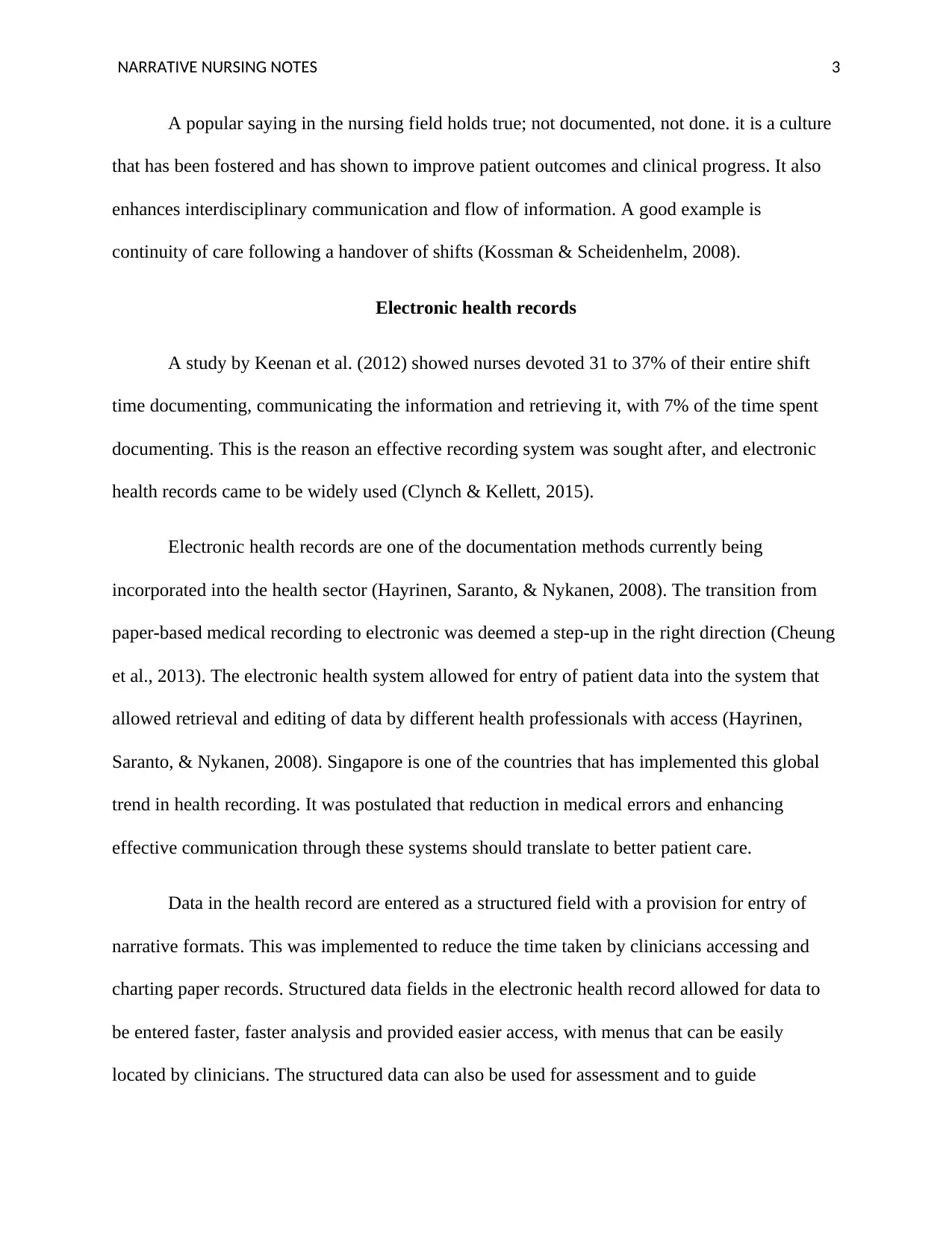
NARRATIVE NURSING NOTES 3
A popular saying in the nursing field holds true; not documented, not done. it is a culture
that has been fostered and has shown to improve patient outcomes and clinical progress. It also
enhances interdisciplinary communication and flow of information. A good example is
continuity of care following a handover of shifts (Kossman & Scheidenhelm, 2008).
Electronic health records
A study by Keenan et al. (2012) showed nurses devoted 31 to 37% of their entire shift
time documenting, communicating the information and retrieving it, with 7% of the time spent
documenting. This is the reason an effective recording system was sought after, and electronic
health records came to be widely used (Clynch & Kellett, 2015).
Electronic health records are one of the documentation methods currently being
incorporated into the health sector (Hayrinen, Saranto, & Nykanen, 2008). The transition from
paper-based medical recording to electronic was deemed a step-up in the right direction (Cheung
et al., 2013). The electronic health system allowed for entry of patient data into the system that
allowed retrieval and editing of data by different health professionals with access (Hayrinen,
Saranto, & Nykanen, 2008). Singapore is one of the countries that has implemented this global
trend in health recording. It was postulated that reduction in medical errors and enhancing
effective communication through these systems should translate to better patient care.
Data in the health record are entered as a structured field with a provision for entry of
narrative formats. This was implemented to reduce the time taken by clinicians accessing and
charting paper records. Structured data fields in the electronic health record allowed for data to
be entered faster, faster analysis and provided easier access, with menus that can be easily
located by clinicians. The structured data can also be used for assessment and to guide
A popular saying in the nursing field holds true; not documented, not done. it is a culture
that has been fostered and has shown to improve patient outcomes and clinical progress. It also
enhances interdisciplinary communication and flow of information. A good example is
continuity of care following a handover of shifts (Kossman & Scheidenhelm, 2008).
Electronic health records
A study by Keenan et al. (2012) showed nurses devoted 31 to 37% of their entire shift
time documenting, communicating the information and retrieving it, with 7% of the time spent
documenting. This is the reason an effective recording system was sought after, and electronic
health records came to be widely used (Clynch & Kellett, 2015).
Electronic health records are one of the documentation methods currently being
incorporated into the health sector (Hayrinen, Saranto, & Nykanen, 2008). The transition from
paper-based medical recording to electronic was deemed a step-up in the right direction (Cheung
et al., 2013). The electronic health system allowed for entry of patient data into the system that
allowed retrieval and editing of data by different health professionals with access (Hayrinen,
Saranto, & Nykanen, 2008). Singapore is one of the countries that has implemented this global
trend in health recording. It was postulated that reduction in medical errors and enhancing
effective communication through these systems should translate to better patient care.
Data in the health record are entered as a structured field with a provision for entry of
narrative formats. This was implemented to reduce the time taken by clinicians accessing and
charting paper records. Structured data fields in the electronic health record allowed for data to
be entered faster, faster analysis and provided easier access, with menus that can be easily
located by clinicians. The structured data can also be used for assessment and to guide
⊘ This is a preview!⊘
Do you want full access?
Subscribe today to unlock all pages.

Trusted by 1+ million students worldwide
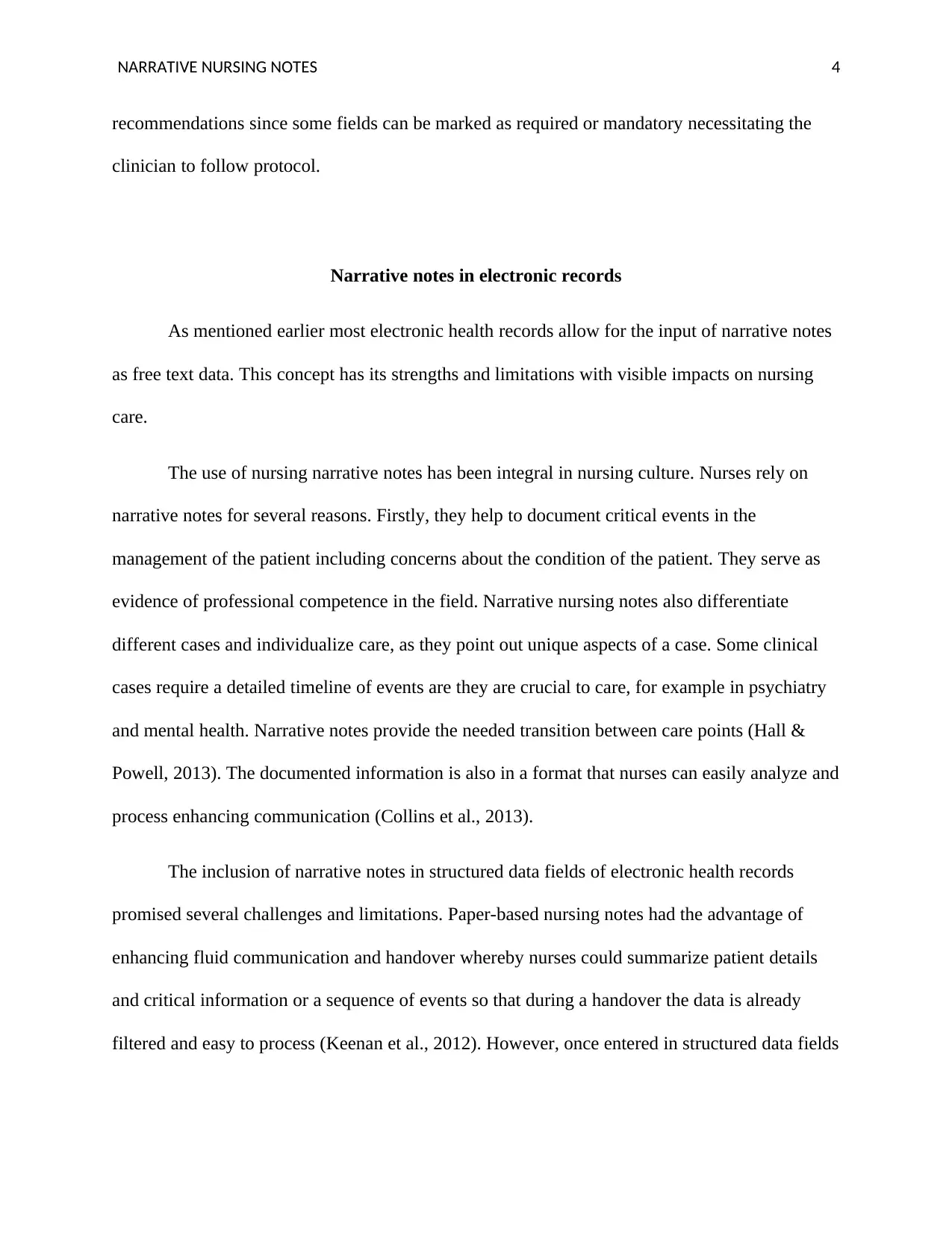
NARRATIVE NURSING NOTES 4
recommendations since some fields can be marked as required or mandatory necessitating the
clinician to follow protocol.
Narrative notes in electronic records
As mentioned earlier most electronic health records allow for the input of narrative notes
as free text data. This concept has its strengths and limitations with visible impacts on nursing
care.
The use of nursing narrative notes has been integral in nursing culture. Nurses rely on
narrative notes for several reasons. Firstly, they help to document critical events in the
management of the patient including concerns about the condition of the patient. They serve as
evidence of professional competence in the field. Narrative nursing notes also differentiate
different cases and individualize care, as they point out unique aspects of a case. Some clinical
cases require a detailed timeline of events are they are crucial to care, for example in psychiatry
and mental health. Narrative notes provide the needed transition between care points (Hall &
Powell, 2013). The documented information is also in a format that nurses can easily analyze and
process enhancing communication (Collins et al., 2013).
The inclusion of narrative notes in structured data fields of electronic health records
promised several challenges and limitations. Paper-based nursing notes had the advantage of
enhancing fluid communication and handover whereby nurses could summarize patient details
and critical information or a sequence of events so that during a handover the data is already
filtered and easy to process (Keenan et al., 2012). However, once entered in structured data fields
recommendations since some fields can be marked as required or mandatory necessitating the
clinician to follow protocol.
Narrative notes in electronic records
As mentioned earlier most electronic health records allow for the input of narrative notes
as free text data. This concept has its strengths and limitations with visible impacts on nursing
care.
The use of nursing narrative notes has been integral in nursing culture. Nurses rely on
narrative notes for several reasons. Firstly, they help to document critical events in the
management of the patient including concerns about the condition of the patient. They serve as
evidence of professional competence in the field. Narrative nursing notes also differentiate
different cases and individualize care, as they point out unique aspects of a case. Some clinical
cases require a detailed timeline of events are they are crucial to care, for example in psychiatry
and mental health. Narrative notes provide the needed transition between care points (Hall &
Powell, 2013). The documented information is also in a format that nurses can easily analyze and
process enhancing communication (Collins et al., 2013).
The inclusion of narrative notes in structured data fields of electronic health records
promised several challenges and limitations. Paper-based nursing notes had the advantage of
enhancing fluid communication and handover whereby nurses could summarize patient details
and critical information or a sequence of events so that during a handover the data is already
filtered and easy to process (Keenan et al., 2012). However, once entered in structured data fields
Paraphrase This Document
Need a fresh take? Get an instant paraphrase of this document with our AI Paraphraser
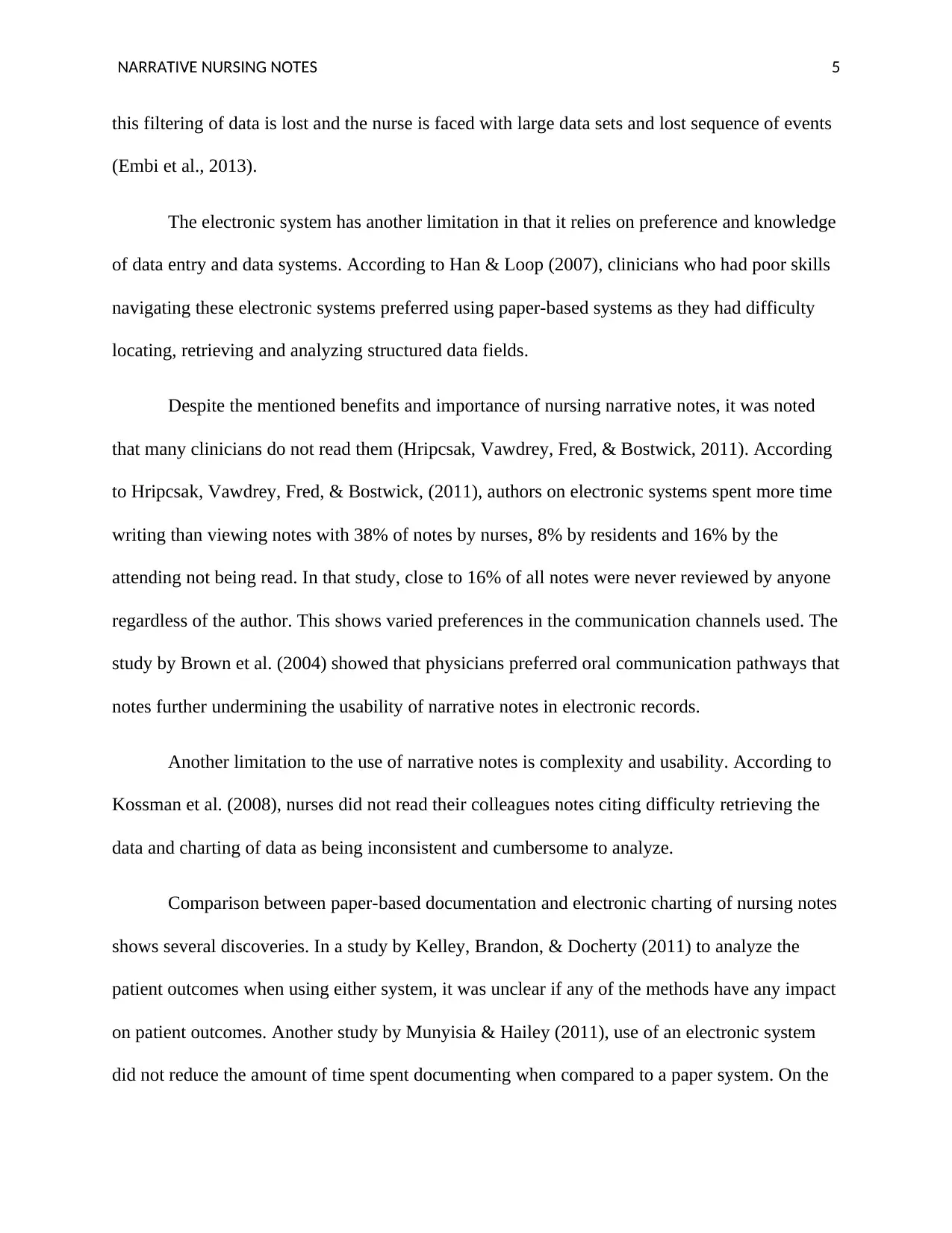
NARRATIVE NURSING NOTES 5
this filtering of data is lost and the nurse is faced with large data sets and lost sequence of events
(Embi et al., 2013).
The electronic system has another limitation in that it relies on preference and knowledge
of data entry and data systems. According to Han & Loop (2007), clinicians who had poor skills
navigating these electronic systems preferred using paper-based systems as they had difficulty
locating, retrieving and analyzing structured data fields.
Despite the mentioned benefits and importance of nursing narrative notes, it was noted
that many clinicians do not read them (Hripcsak, Vawdrey, Fred, & Bostwick, 2011). According
to Hripcsak, Vawdrey, Fred, & Bostwick, (2011), authors on electronic systems spent more time
writing than viewing notes with 38% of notes by nurses, 8% by residents and 16% by the
attending not being read. In that study, close to 16% of all notes were never reviewed by anyone
regardless of the author. This shows varied preferences in the communication channels used. The
study by Brown et al. (2004) showed that physicians preferred oral communication pathways that
notes further undermining the usability of narrative notes in electronic records.
Another limitation to the use of narrative notes is complexity and usability. According to
Kossman et al. (2008), nurses did not read their colleagues notes citing difficulty retrieving the
data and charting of data as being inconsistent and cumbersome to analyze.
Comparison between paper-based documentation and electronic charting of nursing notes
shows several discoveries. In a study by Kelley, Brandon, & Docherty (2011) to analyze the
patient outcomes when using either system, it was unclear if any of the methods have any impact
on patient outcomes. Another study by Munyisia & Hailey (2011), use of an electronic system
did not reduce the amount of time spent documenting when compared to a paper system. On the
this filtering of data is lost and the nurse is faced with large data sets and lost sequence of events
(Embi et al., 2013).
The electronic system has another limitation in that it relies on preference and knowledge
of data entry and data systems. According to Han & Loop (2007), clinicians who had poor skills
navigating these electronic systems preferred using paper-based systems as they had difficulty
locating, retrieving and analyzing structured data fields.
Despite the mentioned benefits and importance of nursing narrative notes, it was noted
that many clinicians do not read them (Hripcsak, Vawdrey, Fred, & Bostwick, 2011). According
to Hripcsak, Vawdrey, Fred, & Bostwick, (2011), authors on electronic systems spent more time
writing than viewing notes with 38% of notes by nurses, 8% by residents and 16% by the
attending not being read. In that study, close to 16% of all notes were never reviewed by anyone
regardless of the author. This shows varied preferences in the communication channels used. The
study by Brown et al. (2004) showed that physicians preferred oral communication pathways that
notes further undermining the usability of narrative notes in electronic records.
Another limitation to the use of narrative notes is complexity and usability. According to
Kossman et al. (2008), nurses did not read their colleagues notes citing difficulty retrieving the
data and charting of data as being inconsistent and cumbersome to analyze.
Comparison between paper-based documentation and electronic charting of nursing notes
shows several discoveries. In a study by Kelley, Brandon, & Docherty (2011) to analyze the
patient outcomes when using either system, it was unclear if any of the methods have any impact
on patient outcomes. Another study by Munyisia & Hailey (2011), use of an electronic system
did not reduce the amount of time spent documenting when compared to a paper system. On the
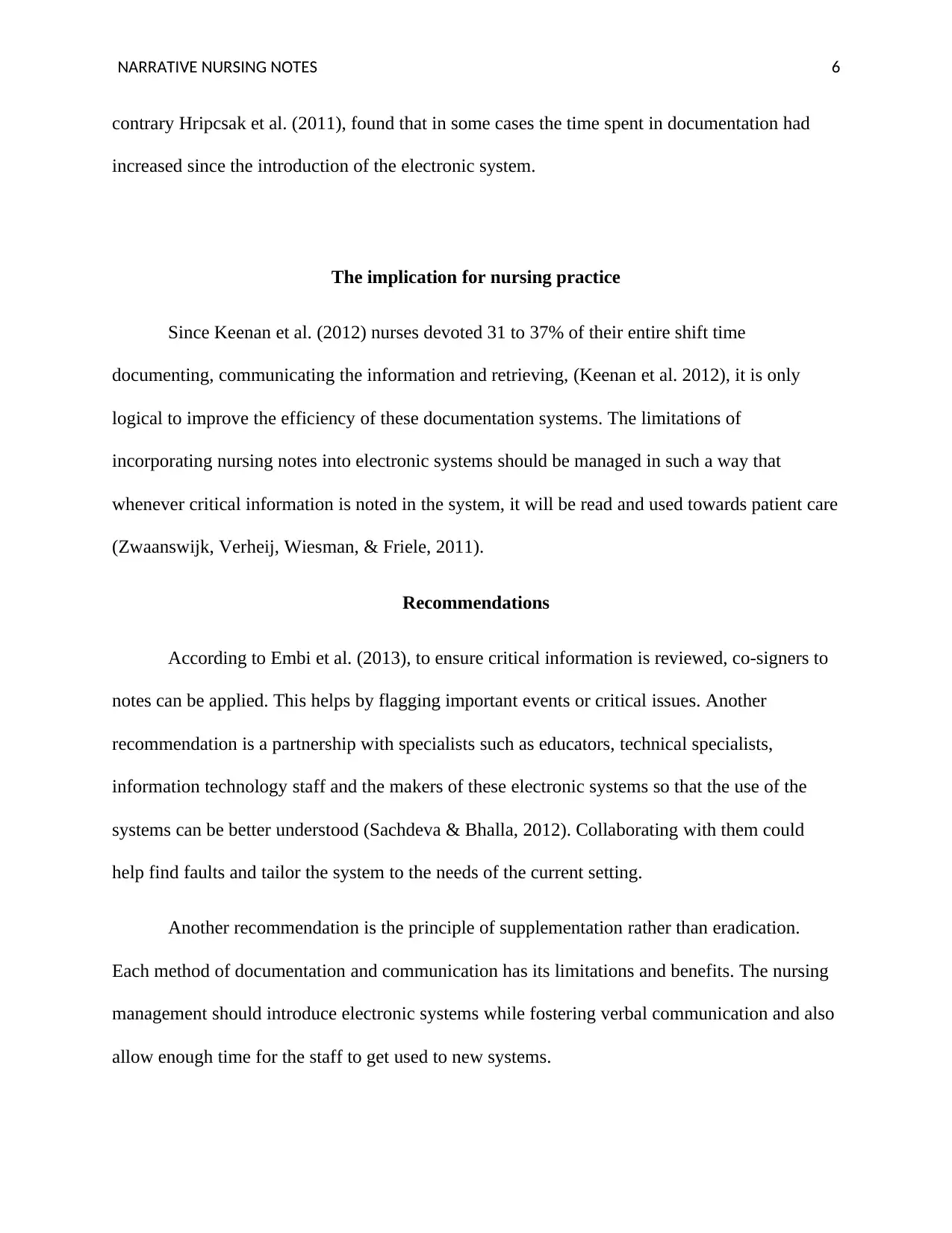
NARRATIVE NURSING NOTES 6
contrary Hripcsak et al. (2011), found that in some cases the time spent in documentation had
increased since the introduction of the electronic system.
The implication for nursing practice
Since Keenan et al. (2012) nurses devoted 31 to 37% of their entire shift time
documenting, communicating the information and retrieving, (Keenan et al. 2012), it is only
logical to improve the efficiency of these documentation systems. The limitations of
incorporating nursing notes into electronic systems should be managed in such a way that
whenever critical information is noted in the system, it will be read and used towards patient care
(Zwaanswijk, Verheij, Wiesman, & Friele, 2011).
Recommendations
According to Embi et al. (2013), to ensure critical information is reviewed, co-signers to
notes can be applied. This helps by flagging important events or critical issues. Another
recommendation is a partnership with specialists such as educators, technical specialists,
information technology staff and the makers of these electronic systems so that the use of the
systems can be better understood (Sachdeva & Bhalla, 2012). Collaborating with them could
help find faults and tailor the system to the needs of the current setting.
Another recommendation is the principle of supplementation rather than eradication.
Each method of documentation and communication has its limitations and benefits. The nursing
management should introduce electronic systems while fostering verbal communication and also
allow enough time for the staff to get used to new systems.
contrary Hripcsak et al. (2011), found that in some cases the time spent in documentation had
increased since the introduction of the electronic system.
The implication for nursing practice
Since Keenan et al. (2012) nurses devoted 31 to 37% of their entire shift time
documenting, communicating the information and retrieving, (Keenan et al. 2012), it is only
logical to improve the efficiency of these documentation systems. The limitations of
incorporating nursing notes into electronic systems should be managed in such a way that
whenever critical information is noted in the system, it will be read and used towards patient care
(Zwaanswijk, Verheij, Wiesman, & Friele, 2011).
Recommendations
According to Embi et al. (2013), to ensure critical information is reviewed, co-signers to
notes can be applied. This helps by flagging important events or critical issues. Another
recommendation is a partnership with specialists such as educators, technical specialists,
information technology staff and the makers of these electronic systems so that the use of the
systems can be better understood (Sachdeva & Bhalla, 2012). Collaborating with them could
help find faults and tailor the system to the needs of the current setting.
Another recommendation is the principle of supplementation rather than eradication.
Each method of documentation and communication has its limitations and benefits. The nursing
management should introduce electronic systems while fostering verbal communication and also
allow enough time for the staff to get used to new systems.
⊘ This is a preview!⊘
Do you want full access?
Subscribe today to unlock all pages.

Trusted by 1+ million students worldwide
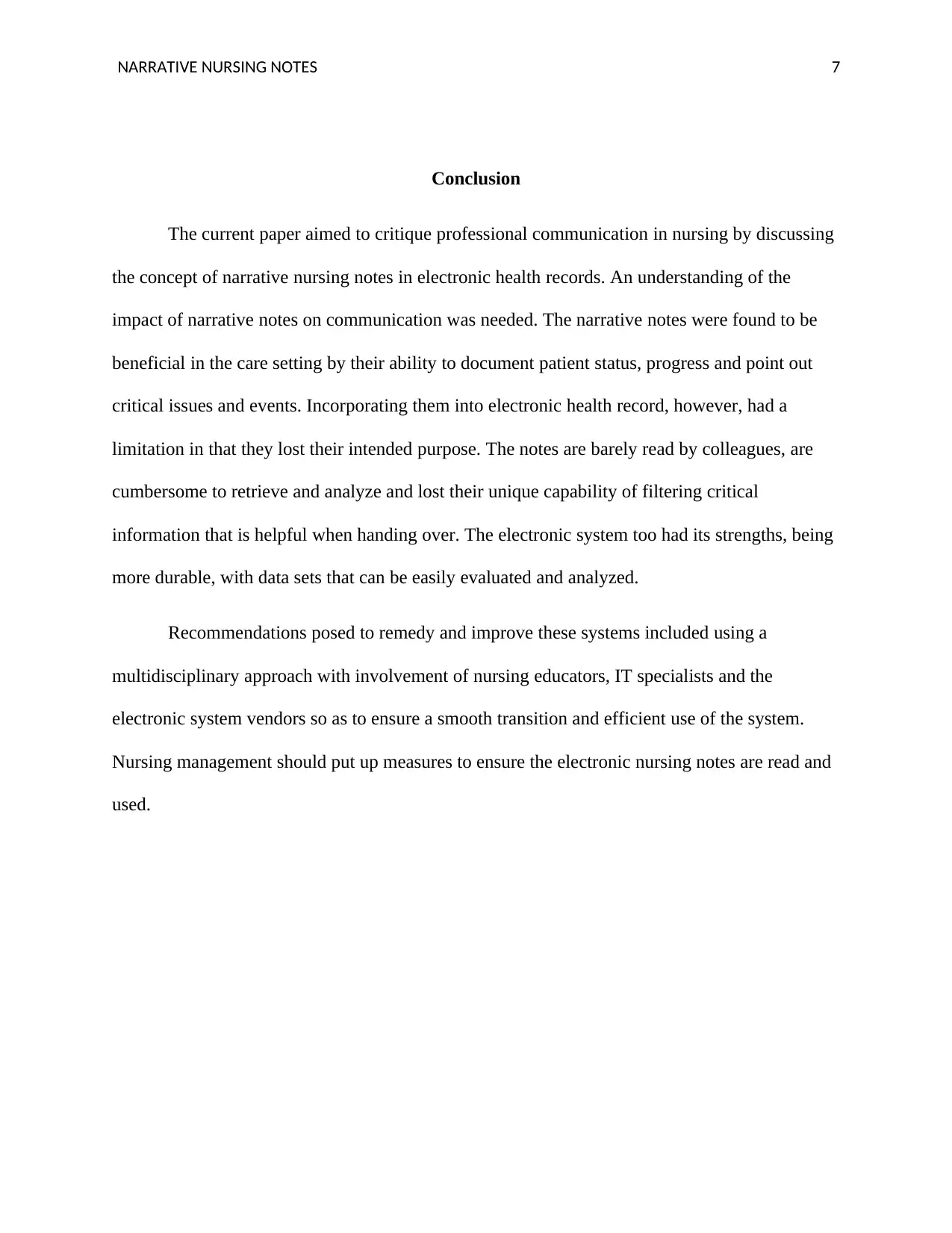
NARRATIVE NURSING NOTES 7
Conclusion
The current paper aimed to critique professional communication in nursing by discussing
the concept of narrative nursing notes in electronic health records. An understanding of the
impact of narrative notes on communication was needed. The narrative notes were found to be
beneficial in the care setting by their ability to document patient status, progress and point out
critical issues and events. Incorporating them into electronic health record, however, had a
limitation in that they lost their intended purpose. The notes are barely read by colleagues, are
cumbersome to retrieve and analyze and lost their unique capability of filtering critical
information that is helpful when handing over. The electronic system too had its strengths, being
more durable, with data sets that can be easily evaluated and analyzed.
Recommendations posed to remedy and improve these systems included using a
multidisciplinary approach with involvement of nursing educators, IT specialists and the
electronic system vendors so as to ensure a smooth transition and efficient use of the system.
Nursing management should put up measures to ensure the electronic nursing notes are read and
used.
Conclusion
The current paper aimed to critique professional communication in nursing by discussing
the concept of narrative nursing notes in electronic health records. An understanding of the
impact of narrative notes on communication was needed. The narrative notes were found to be
beneficial in the care setting by their ability to document patient status, progress and point out
critical issues and events. Incorporating them into electronic health record, however, had a
limitation in that they lost their intended purpose. The notes are barely read by colleagues, are
cumbersome to retrieve and analyze and lost their unique capability of filtering critical
information that is helpful when handing over. The electronic system too had its strengths, being
more durable, with data sets that can be easily evaluated and analyzed.
Recommendations posed to remedy and improve these systems included using a
multidisciplinary approach with involvement of nursing educators, IT specialists and the
electronic system vendors so as to ensure a smooth transition and efficient use of the system.
Nursing management should put up measures to ensure the electronic nursing notes are read and
used.
Paraphrase This Document
Need a fresh take? Get an instant paraphrase of this document with our AI Paraphraser
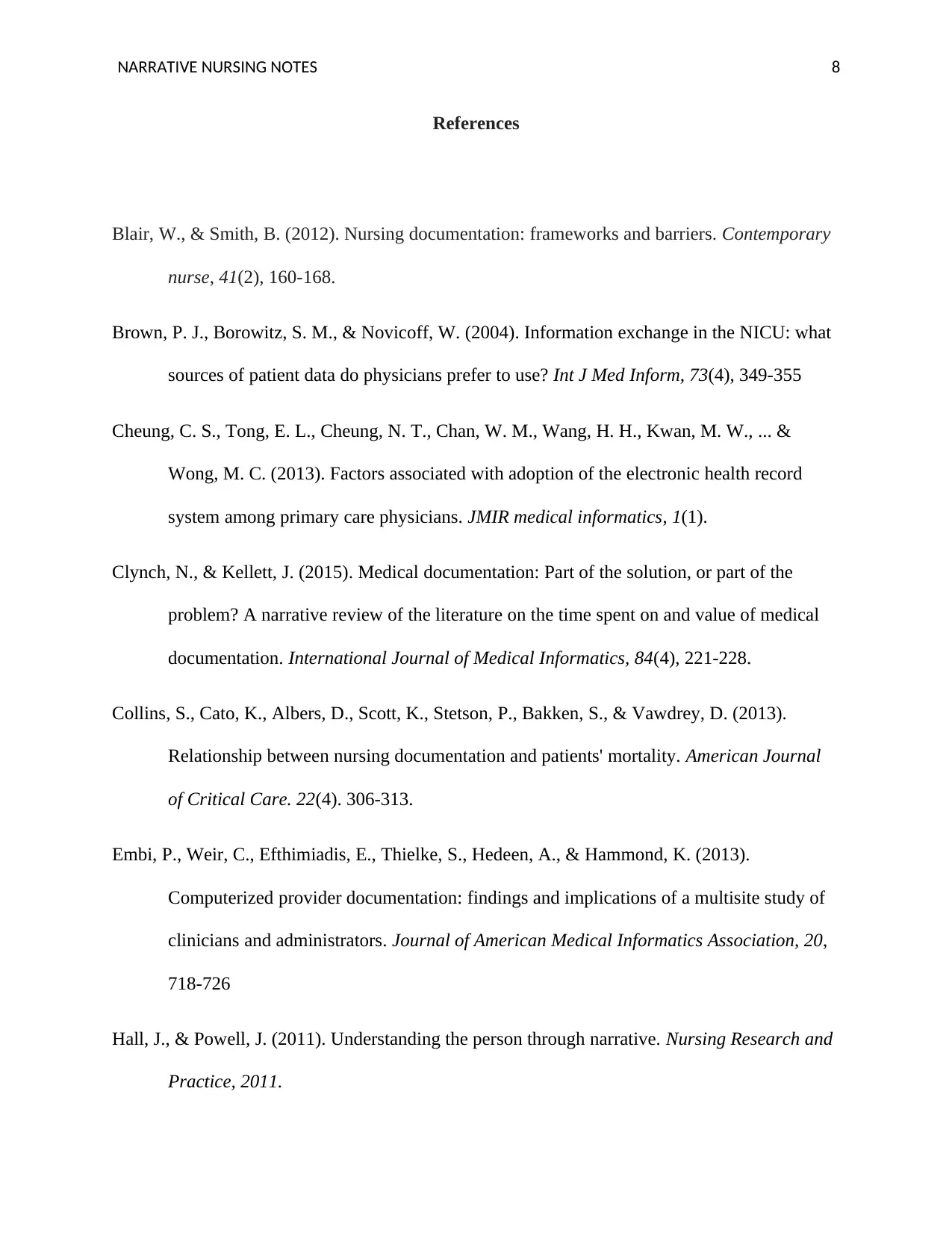
NARRATIVE NURSING NOTES 8
References
Blair, W., & Smith, B. (2012). Nursing documentation: frameworks and barriers. Contemporary
nurse, 41(2), 160-168.
Brown, P. J., Borowitz, S. M., & Novicoff, W. (2004). Information exchange in the NICU: what
sources of patient data do physicians prefer to use? Int J Med Inform, 73(4), 349-355
Cheung, C. S., Tong, E. L., Cheung, N. T., Chan, W. M., Wang, H. H., Kwan, M. W., ... &
Wong, M. C. (2013). Factors associated with adoption of the electronic health record
system among primary care physicians. JMIR medical informatics, 1(1).
Clynch, N., & Kellett, J. (2015). Medical documentation: Part of the solution, or part of the
problem? A narrative review of the literature on the time spent on and value of medical
documentation. International Journal of Medical Informatics, 84(4), 221-228.
Collins, S., Cato, K., Albers, D., Scott, K., Stetson, P., Bakken, S., & Vawdrey, D. (2013).
Relationship between nursing documentation and patients' mortality. American Journal
of Critical Care. 22(4). 306-313.
Embi, P., Weir, C., Efthimiadis, E., Thielke, S., Hedeen, A., & Hammond, K. (2013).
Computerized provider documentation: findings and implications of a multisite study of
clinicians and administrators. Journal of American Medical Informatics Association, 20,
718-726
Hall, J., & Powell, J. (2011). Understanding the person through narrative. Nursing Research and
Practice, 2011.
References
Blair, W., & Smith, B. (2012). Nursing documentation: frameworks and barriers. Contemporary
nurse, 41(2), 160-168.
Brown, P. J., Borowitz, S. M., & Novicoff, W. (2004). Information exchange in the NICU: what
sources of patient data do physicians prefer to use? Int J Med Inform, 73(4), 349-355
Cheung, C. S., Tong, E. L., Cheung, N. T., Chan, W. M., Wang, H. H., Kwan, M. W., ... &
Wong, M. C. (2013). Factors associated with adoption of the electronic health record
system among primary care physicians. JMIR medical informatics, 1(1).
Clynch, N., & Kellett, J. (2015). Medical documentation: Part of the solution, or part of the
problem? A narrative review of the literature on the time spent on and value of medical
documentation. International Journal of Medical Informatics, 84(4), 221-228.
Collins, S., Cato, K., Albers, D., Scott, K., Stetson, P., Bakken, S., & Vawdrey, D. (2013).
Relationship between nursing documentation and patients' mortality. American Journal
of Critical Care. 22(4). 306-313.
Embi, P., Weir, C., Efthimiadis, E., Thielke, S., Hedeen, A., & Hammond, K. (2013).
Computerized provider documentation: findings and implications of a multisite study of
clinicians and administrators. Journal of American Medical Informatics Association, 20,
718-726
Hall, J., & Powell, J. (2011). Understanding the person through narrative. Nursing Research and
Practice, 2011.
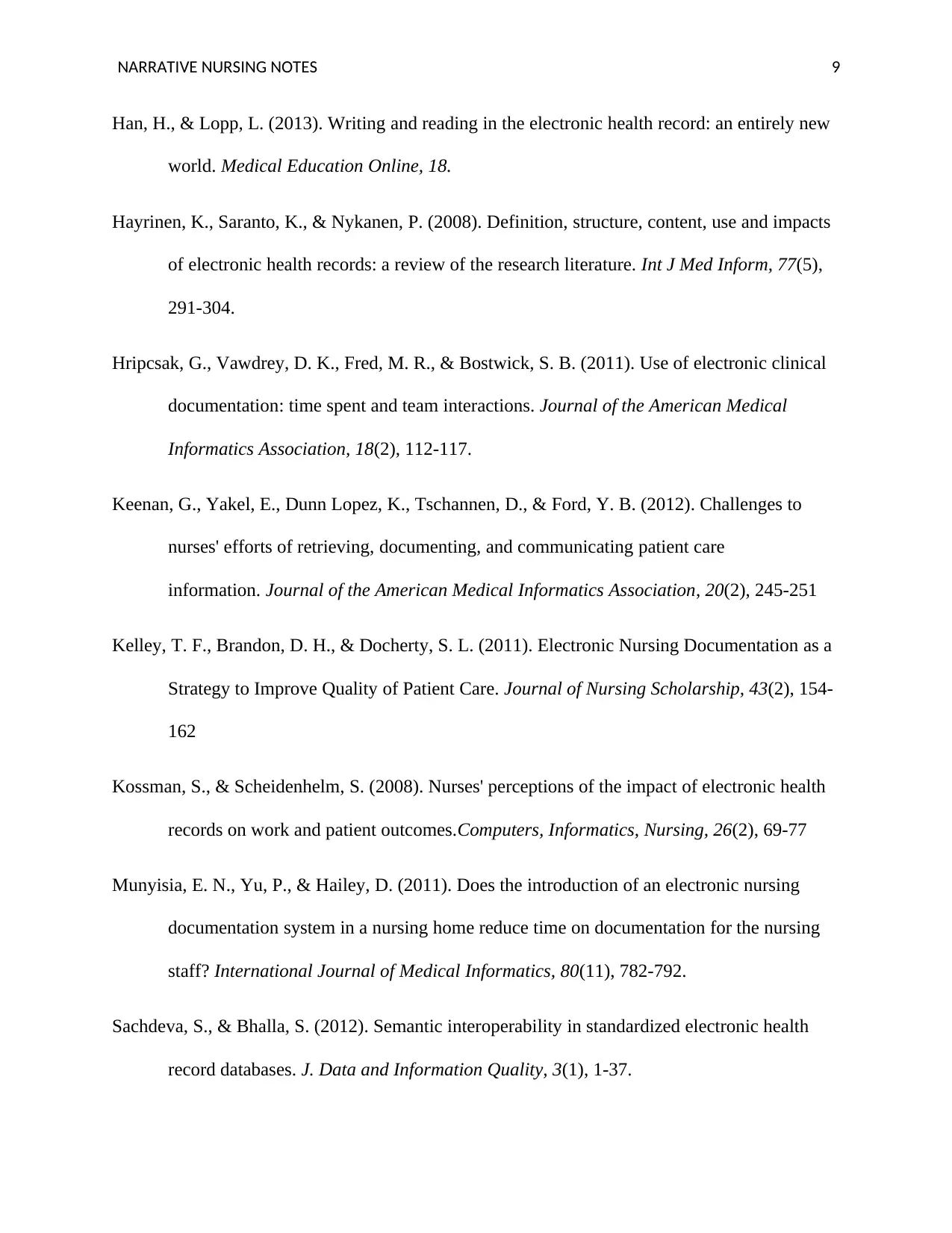
NARRATIVE NURSING NOTES 9
Han, H., & Lopp, L. (2013). Writing and reading in the electronic health record: an entirely new
world. Medical Education Online, 18.
Hayrinen, K., Saranto, K., & Nykanen, P. (2008). Definition, structure, content, use and impacts
of electronic health records: a review of the research literature. Int J Med Inform, 77(5),
291-304.
Hripcsak, G., Vawdrey, D. K., Fred, M. R., & Bostwick, S. B. (2011). Use of electronic clinical
documentation: time spent and team interactions. Journal of the American Medical
Informatics Association, 18(2), 112-117.
Keenan, G., Yakel, E., Dunn Lopez, K., Tschannen, D., & Ford, Y. B. (2012). Challenges to
nurses' efforts of retrieving, documenting, and communicating patient care
information. Journal of the American Medical Informatics Association, 20(2), 245-251
Kelley, T. F., Brandon, D. H., & Docherty, S. L. (2011). Electronic Nursing Documentation as a
Strategy to Improve Quality of Patient Care. Journal of Nursing Scholarship, 43(2), 154-
162
Kossman, S., & Scheidenhelm, S. (2008). Nurses' perceptions of the impact of electronic health
records on work and patient outcomes.Computers, Informatics, Nursing, 26(2), 69-77
Munyisia, E. N., Yu, P., & Hailey, D. (2011). Does the introduction of an electronic nursing
documentation system in a nursing home reduce time on documentation for the nursing
staff? International Journal of Medical Informatics, 80(11), 782-792.
Sachdeva, S., & Bhalla, S. (2012). Semantic interoperability in standardized electronic health
record databases. J. Data and Information Quality, 3(1), 1-37.
Han, H., & Lopp, L. (2013). Writing and reading in the electronic health record: an entirely new
world. Medical Education Online, 18.
Hayrinen, K., Saranto, K., & Nykanen, P. (2008). Definition, structure, content, use and impacts
of electronic health records: a review of the research literature. Int J Med Inform, 77(5),
291-304.
Hripcsak, G., Vawdrey, D. K., Fred, M. R., & Bostwick, S. B. (2011). Use of electronic clinical
documentation: time spent and team interactions. Journal of the American Medical
Informatics Association, 18(2), 112-117.
Keenan, G., Yakel, E., Dunn Lopez, K., Tschannen, D., & Ford, Y. B. (2012). Challenges to
nurses' efforts of retrieving, documenting, and communicating patient care
information. Journal of the American Medical Informatics Association, 20(2), 245-251
Kelley, T. F., Brandon, D. H., & Docherty, S. L. (2011). Electronic Nursing Documentation as a
Strategy to Improve Quality of Patient Care. Journal of Nursing Scholarship, 43(2), 154-
162
Kossman, S., & Scheidenhelm, S. (2008). Nurses' perceptions of the impact of electronic health
records on work and patient outcomes.Computers, Informatics, Nursing, 26(2), 69-77
Munyisia, E. N., Yu, P., & Hailey, D. (2011). Does the introduction of an electronic nursing
documentation system in a nursing home reduce time on documentation for the nursing
staff? International Journal of Medical Informatics, 80(11), 782-792.
Sachdeva, S., & Bhalla, S. (2012). Semantic interoperability in standardized electronic health
record databases. J. Data and Information Quality, 3(1), 1-37.
⊘ This is a preview!⊘
Do you want full access?
Subscribe today to unlock all pages.

Trusted by 1+ million students worldwide
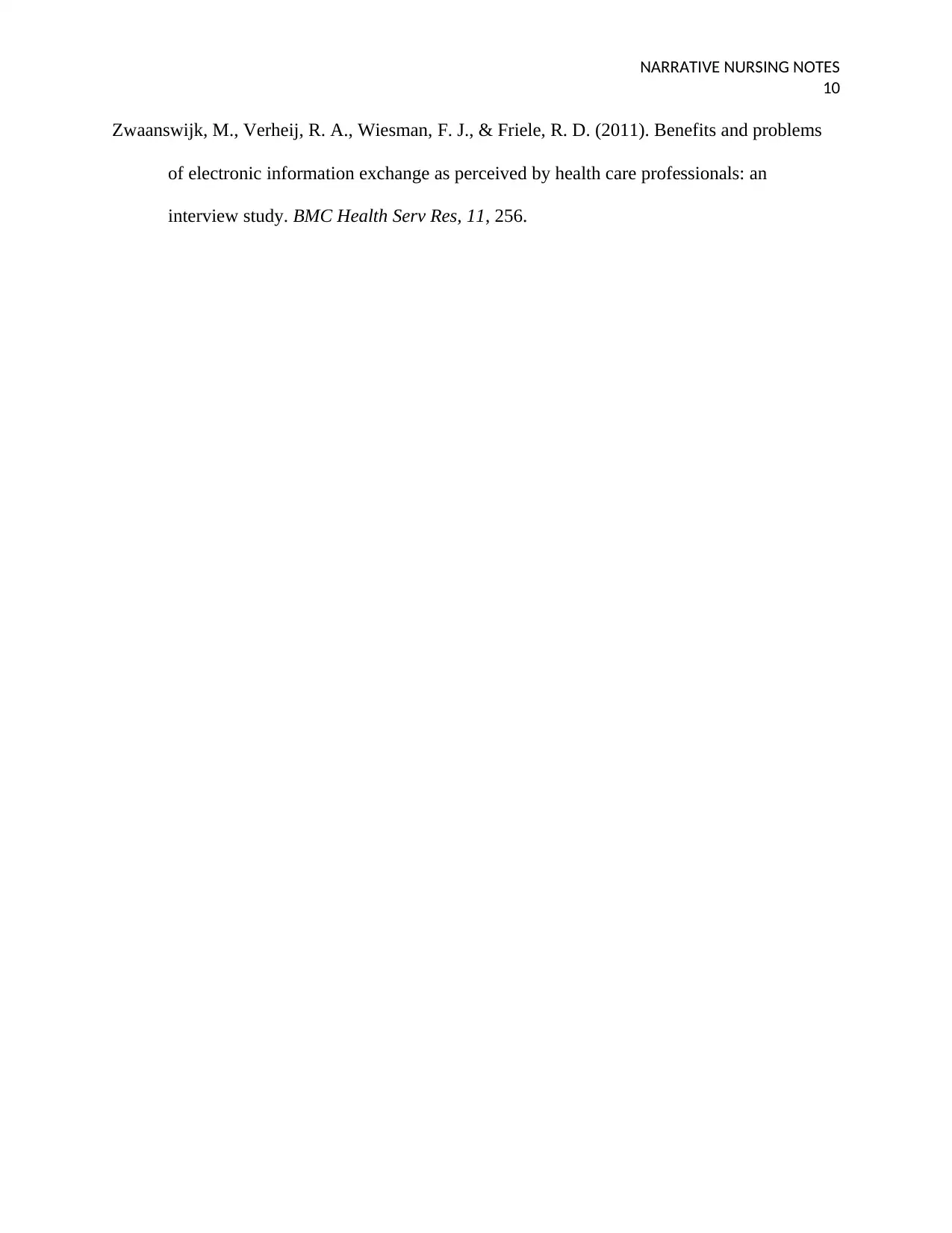
NARRATIVE NURSING NOTES
10
Zwaanswijk, M., Verheij, R. A., Wiesman, F. J., & Friele, R. D. (2011). Benefits and problems
of electronic information exchange as perceived by health care professionals: an
interview study. BMC Health Serv Res, 11, 256.
10
Zwaanswijk, M., Verheij, R. A., Wiesman, F. J., & Friele, R. D. (2011). Benefits and problems
of electronic information exchange as perceived by health care professionals: an
interview study. BMC Health Serv Res, 11, 256.
1 out of 10
Related Documents
Your All-in-One AI-Powered Toolkit for Academic Success.
+13062052269
info@desklib.com
Available 24*7 on WhatsApp / Email
![[object Object]](/_next/static/media/star-bottom.7253800d.svg)
Unlock your academic potential
Copyright © 2020–2025 A2Z Services. All Rights Reserved. Developed and managed by ZUCOL.





